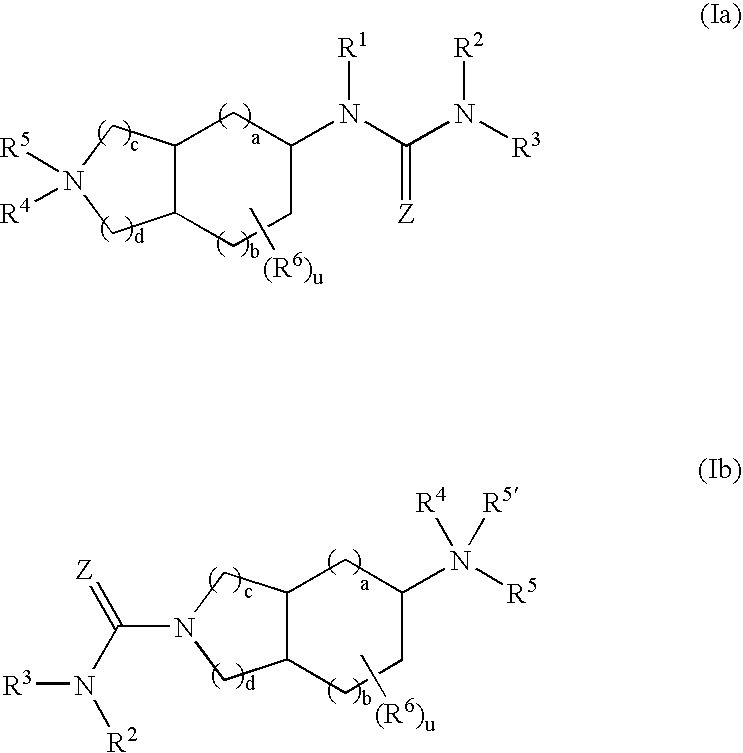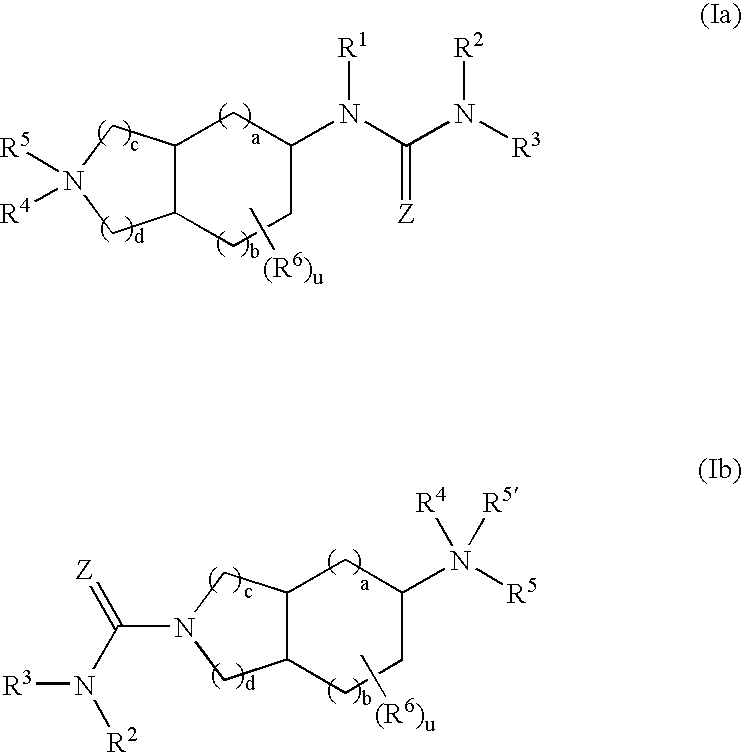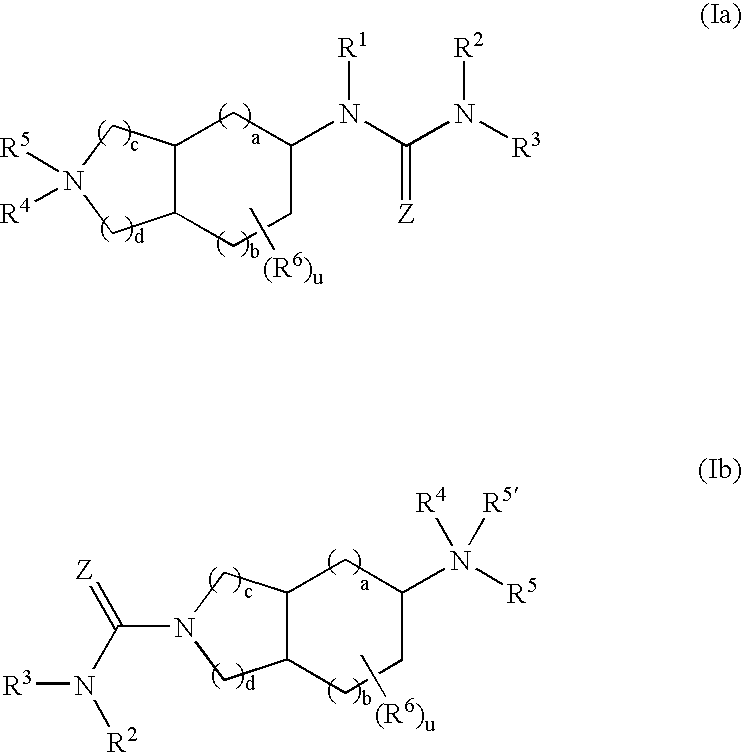Substituted fused bicyclic amines as modulators of chemokine receptor activity
a technology fusion amine, which is applied in the field of modulators of chemokine receptor activity, can solve the problems that the prior art does not disclose nor suggest the unique combination of structural fragments
- Summary
- Abstract
- Description
- Claims
- Application Information
AI Technical Summary
Benefits of technology
Problems solved by technology
Method used
Image
Examples
example 1
Part A: Preparation of 3-bromo-5-nitrobenzoic acid
[0175] A solution of 3-nitrobenzoic acid (16.7 g, 100 mmol) in trifluoroacetic acid (50 mL) and sulfuric acid (20 mL) was stirred at 50° C., and N-bromosuccinimide (26.7 g, 150 mmol) was added in three portions over 3 hours. The mixture was stirred for 16 hours and then cooled to room temperature. The mixture was then poured into ice water (200 mL) and extracted three times with ethyl acetate. The organic layers were combined, dried over sodium sulfate and concentrated under vacuum. The residue was recrystallized from dichloromethane to provide a white solid (17.7 g, 72%). 1H NMR (300 MHz, DMSO-d6) δ13.8 (bs, 1H), 8.60 (s, 1H), 8.55 (s, 1H), 8.37 (s, 1H).
Part B: Preparation of N-methyl-3-bromo-5-nitrobenzamide
[0176] A suspension of 3-bromo-5-nitrobenzoic acid (7.10 g, 28.9 mmol) in dichloromethane (50 mL) was treated with oxalyl chloride (5.04 mL, 57.7 mmol) and a few drops of N,N-dimethylformamide, producing gas evolution. Afte...
example 2
Part A: Preparation of hexa-3,5-dien-1-yl 4-methylbenzenesulfonate
[0185] A solution of ethyl hexa-3,5-dienoate (4.0 g, 28.6 mmol) in dry tetrahydrofuran (200 mL) was treated with a solution of lithium aluminum hydride in tetrahydrofuran (1.0 M, 28.6 mL, 28.6 mmol). The mixture was stirred at room temperature for 2 hours, and then quenched with water. The mixture was acidified with 1.0 N aqueous hydrochloric acid and extracted three times with ethyl acetate. The organic layers were combined, dried over sodium sulfate and concentrated to a yellow oil. 1H NMR (300 MHz, CDCl3) δ6.4-6.1 (m, 2H), 5.67 (m, 1H), 5.13 (d, J=17 Hz, 1H), 5.00 (d, J=11 Hz, 1H), 3.66 (t, J=6.6 Hz, 2H), 2.34 (q, J=6.6 Hz, 2H), 2.13 (broad s, 1H). The oil was dissolved in dichloromethane, cooled to 0° C. and treated with pyridine (10 mL) and p-toluenesulfonyl chloride (5.72 g, 30 mmol). The mixture was stirred for one hour, then warmed to room temperature and stirred for 3 hours. The mixture was then concentrate...
example 5
Part A: Preparation of t-butyl 3-oxo-1-piperidinecarboxylate
[0195] To a stirred solution of N-benzyl-3-piperidone hydrochloride hydrate (4.2 g, 18.6 mmol) and 10% palladium on carbon (0.8 g) in degassed methanol (200 mL) was added hydrogen gas to 55 psi. The reaction mixture was stirred for 16 hr and then filtered through a pad of celite. The celite was washed with methanol (200 mL). The filtrates were combined and concentrated in vacuo to a colorless oil. The oil was dissolved in tetrahydrofuran (200 mL) and then treated with di-t-butyl-dicarbonate (5.27 g, 24.1 mmol) and a saturated aqueous sodium bicarbonate solution (50 mL). The reaction was stirred for 4 hr and then concentrated in vacuo to a white solid. The solid was partitioned between ethyl acetate and 1N hydrochloric acid. The organic layer was separated, washed with 1N sodium hydroxide and brine, dried over Na2SO4, and evaporated in vacuo to a colorless oil. The oil was purified by flash chromatography (silica gel, hexa...
PUM
| Property | Measurement | Unit |
|---|---|---|
| Fraction | aaaaa | aaaaa |
| Force | aaaaa | aaaaa |
| Electrical conductance | aaaaa | aaaaa |
Abstract
Description
Claims
Application Information
 Login to View More
Login to View More - R&D
- Intellectual Property
- Life Sciences
- Materials
- Tech Scout
- Unparalleled Data Quality
- Higher Quality Content
- 60% Fewer Hallucinations
Browse by: Latest US Patents, China's latest patents, Technical Efficacy Thesaurus, Application Domain, Technology Topic, Popular Technical Reports.
© 2025 PatSnap. All rights reserved.Legal|Privacy policy|Modern Slavery Act Transparency Statement|Sitemap|About US| Contact US: help@patsnap.com



